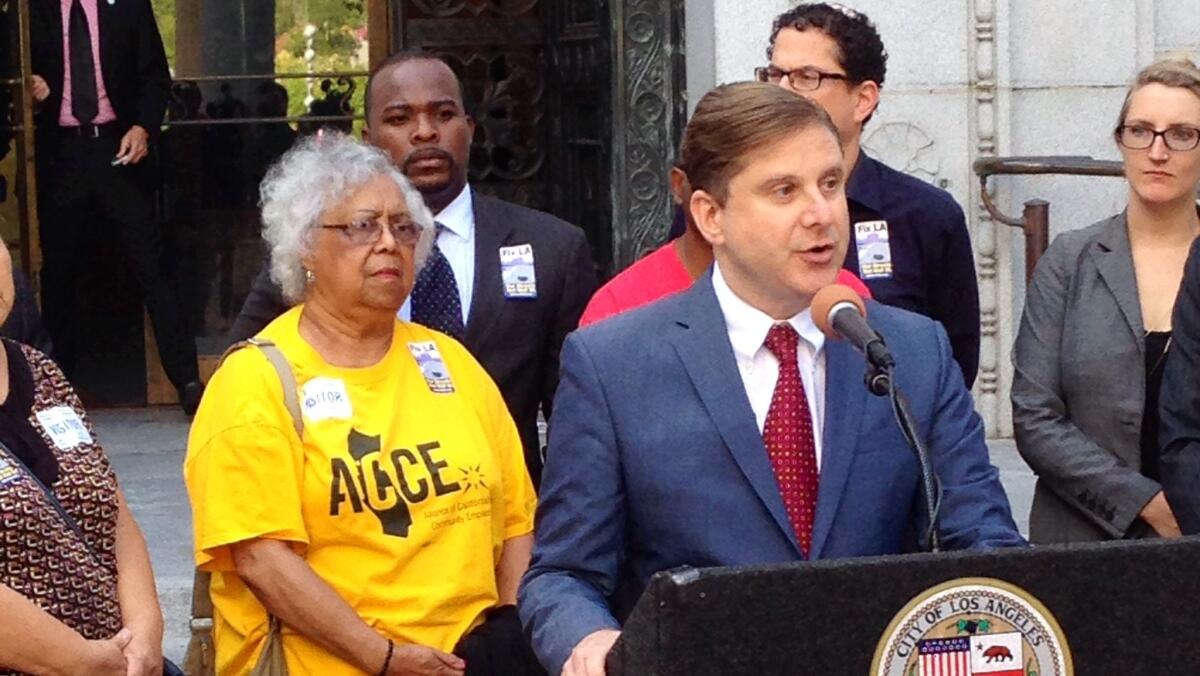Opinion: L.A. should try again to curb blight caused by foreclosures

The housing crisis that nearly brought the nationâs economy to a standstill hit hard in Los Angeles, particularly in its most vulnerable neighborhoods. Banks foreclosed on more than 56,000 single-family and multi-residential units in the area between 2007 and 2013, but they often made virtually no effort to maintain those properties after evicting the former owners, leading to hideous and dangerous blight. In 2010, the City Council came up with an ambitious program â the Foreclosure Registry Program â to fine scofflaw banks up to $1,000 a day for neglecting the properties they took over in foreclosure. But then the city failed to collect a single dollar.
Tuesday morning, at a news conference outside of City Hall, Controller Ron Galperin spoke about his officeâs newly released audit detailing the overwhelming ineffectiveness of the registry program, and offering an alternative proposal to replace it.
The gripes included a requirement for lenders to register properties with the city before they even legally possessed them, as well as flaws in the registry leading to uncollected fees, incomplete and invalid records, and no formal process for sharing information or enforcement.
Galperin was joined by Councilman Gil Cedillo and Rushmore Cervantes, interim general manager of the Housing and Community Investment Department, both of whom threw their support behind the controller. Cedillo also moved to amend the foreclosure program.
âThis specific ordinance is a tool that has been underutilized,â Cedillo said. âIt makes no benefit to our communities to clean the streets and leave the blight thatâs left behind.
âWith todayâs report, we have finally received clarity and we will continue to champion the changes that need to be done legislatively.â
Beverly Roberts didnât need an official audit to tell her the program wasnât working. Roberts, a longtime resident of South Los Angeles who narrowly avoided foreclosure herself, joined a group of housing activists last week on a visit to a boarded-up house at 111th Street and Watts Avenue. The front was fenced in, she said, but the back was open. Squatters had settled in and the stench of dog feces, trash and general rot pervaded. âI couldnât even go in there with that stench,â she said.âI donât understand how they could live there. It was the worst house Iâve ever seen in my life.â
But dilapidated houses like the one Roberts bemoaned are prevalent and are more than just eyesores. The swimming pools that enhance a yard in good financial times become repositories for fetid water and breeding grounds for mosquitoes bearing West Nile virus when they are left untended on the grounds of foreclosed homes. The houses themselves become focal points for a range of criminal activities. Together, they bring down the property values and damage the lifestyles of homeowners barely holding on to their own houses and dignity.
Though it will depend on new personnel to handle inspections, Galperinâs idea seems promising. Instead of trying to take on the entire housing crisis, his plan focuses on getting the registry to work by forcing banks to pay the fines they earned by ignoring the properties they took over.
âThe best way forward for the council and for the mayor,â said Galperin, âis to revise the current ordinance to bring the registry into the 21st century by building a much more high-tech version of it â a robust georegistry to track foreclosed properties.â
In City Hall, however, the road to inaction is paved with good intentions and bad interpersonal relations within the council. As The Times editorial board noted when it endorsed Galperin for controller last year, the controller has little power of his own; his force lies in his ability to gain the cooperation of City Council members.
Still, the end of Galperinâs news conference offered a hopeful moment when the controller received a bear hug from Cedillo. With that hug, Cedillo seemed to be sending a message that Galperin had his full support for this new effort. But Los Angeles has seen its fair share of empty gestures. To combat corrosive blight, the council should also embrace Galperinâs recommendations.
More to Read
A cure for the common opinion
Get thought-provoking perspectives with our weekly newsletter.
You may occasionally receive promotional content from the Los Angeles Times.










